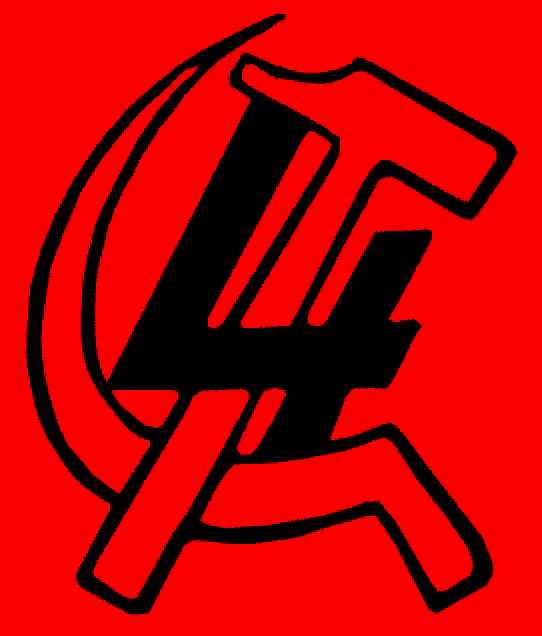
February 2008
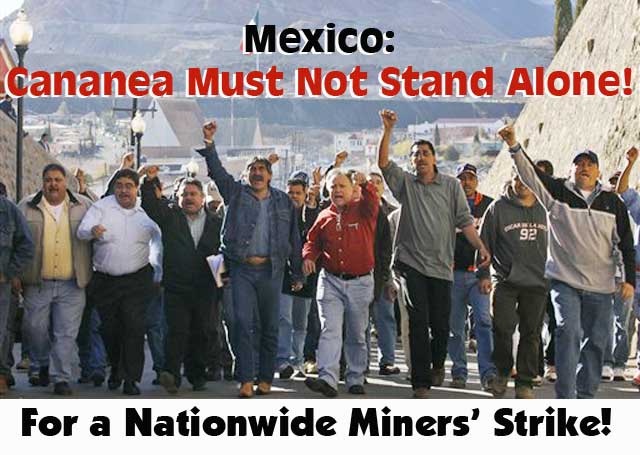
- For a National Strike Against Calderón's Starvation Programs!
- Down with the PRI, PAN and PRD, Parties of the Bourgeoisie!
- Forge a Revolutionary Workers Party!
The following is a translation
of a leaflet distributed in the northern Mexican mining center of
Cananea,
Sonora on February 2 along
with the
accompanying article, “Cananea:
A Century of Internationalist Class Struggle.” (Title photo: Guillermo Arías/AP)
En español: México:
¡Cananea no debe estar sola! (1°
de febrero de 2008)
FEBRUARY 1 –
Once again the Mexican government of Felipe Calderón has run
aground on the
firm and determined resistance of the battle-hardened miners of
Cananea. Some
1,000 federal and state police, the latter dispatched by Sonora
governor
Eduardo Bours, couldn’t handle the 1,300 workers who have shut down the
largest
copper mine in Latin America since last July 30. The advertised
hundreds of
scabs went up in smoke, and the few who offered to help break the
strike
quickly abandoned the empty mine. Felipe had better watch out or he
could end
up shipwrecked on the high desert of Sonora!
Shortly before noon on
January 11, Mexico’s Federal Mediation and Arbitration Board (JFCyA, by
its
initials in Spanish) declared the six-month-old strike of the Sonoran
copper
miners “non-existent.” Hours earlier, an occupation army arrived in
town on
board a caravan of 80 vehicles. Within minutes of the announcement of
the Board
ruling, the repressive forces flooded the streets of Cananea, heading
for the
mine occupied by the strikers for the last 165 days. In the ensuing
skirmishing, at least 50 people were injured, including strikers’ wives
and
children.
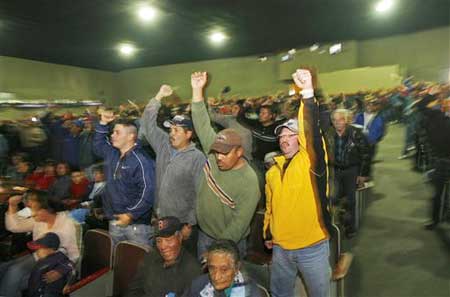 Cananea miners at special meting, January
12, shout their defiance of labor board order declaring their strike
“non-existent.” (Photo: Guillermo Arias/AP
Photo)
Cananea miners at special meting, January
12, shout their defiance of labor board order declaring their strike
“non-existent.” (Photo: Guillermo Arias/AP
Photo)
Even faced with this
assault troop, the miners did not surrender and instead of giving up
they put
up a stubborn resistance. In an article from Cananea, journalists
Felipe Larios
and Fernando Gutiérrez reported in the Hermosillo, Sonora daily Dossier
Político (14 January) that “About 600 out of the 1,287
evicted strikers
managed to regroup and attacked the police officers guarding the mine,
peppering them with metal pellets and Molotov cocktails [bottles filled
with
gasoline], as well as burning several vehicles and damaging company
facilities,
later gathering in front of the mayor’s office to demand that the
police
withdraw from the mine.”
The next day, January 12,
hundreds of miners held a special assembly in the mine where they
shouted
their determination to keep on fighting. They heard from
Napoleón Gómez
Urrutia, the exiled leader of the mineworker organization, speaking by
videoconference from Canada, who called for an end to the repression
and “urged
the workers’ ranks to take back the facilities and once again raise the
red-and-black flag” [that traditionally announces a strike in Mexico].
The assembly also received
a call from an emergency picket outside the Mexican consulate in New
York,
organized by the Internationalist Group, U.S. section of the League for
the
Fourth International. Some 20 demonstrators shouted, “Army out, police
out,
long live the miners strike!” and “Workers struggle knows no borders.”
The
protest included trade-unionists from the UFT (public school teachers),
PSC
(City University faculty) and Teamsters.
Speaking with Sergio
Tolano, head of the mine workers Local 65, one of the demonstrators
commented:
“Here in New York, after the brutal police attack in Oaxaca in 2006, we
pay
close attention to the repressive actions of the Mexican government.”
An
organizer of the protest added, “The Cananea strike of 1906 was a joint
action
of Mexican and American workers. Today we are again urging the U.S.
labor
movement to show active workers solidarity in support of the Cananea
miners.”
The protesters also called
for citizenship rights for immigrant workers in the face of the raids
by the
immigration police. At the same time as the Cananea miners were facing
cops
armed for war, on the other side of the border, Latin American
immigrants in
Arizona are targeted by a new law against undocumented workers while
the hooded
fascists of the Ku Klux Klan openly parade in the streets.
Reports of the NYC protest
were published in an article with a photo in the New York
Spanish-language
daily El Diario-La Prensa, that was picked up by El
Imparcial in
Hermosillo, the state capital of Sonora. A news report was also printed
in Dossier
Político, and a photo of the New York picket line was
prominently featured
in La Jornada in Mexico City.
Struggle Against
Attacks by
the Bosses and Their Government
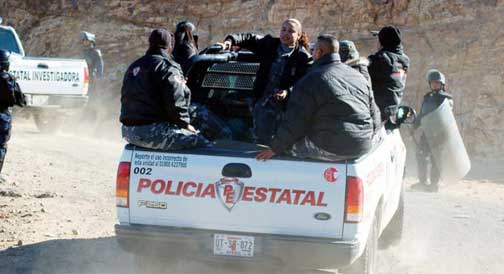
Sonora state police occupying Cananea copper mine in January.
(Photo: Dossier Político [Hermosillo])
The miners are fighting
against the terrible safety conditions in the mines and crushing plant.
The
facilities have sharply deteriorated since the mine was privatized in
1990.
Delegations of American unionists, particularly Steel Workers from
Arizona,
have visited the mine, as they did during previous strikes.
The Mexican government has
repeatedly used the corporatist labor laws, modeled on the labor code
of
Mussolini’s fascist Italy, in order to outlaw the miners’ strike. Even
though
the courts have issued injunctions against the rulings of the JFCyA,
the state
and federal governments have decided in favor of the iron fist of
repression.
Conditions in the Cananea
plant are so notorious that an international team of doctors and
industrial
safety experts which visited the struck plant in October reported they
found a
“clear picture of a work-place being ‘deliberately run into the
ground’.” The
mine is part of the Grupo México, owned by billionaire
Germán Larrea, who also
owns the coal mine at Pasta de Conchos, where 65 miners were buried
alive in
February 2006.
Another grounds for the
strike is to resist the attempts by the Calderón government to
impose a company
union, both locally and nationally. But this attempt has run up against
the
militancy of the Cananea miners, who have gone on strike almost every
year
since 1999, even when they have been stabbed in the back by their
national
mineworker organization.
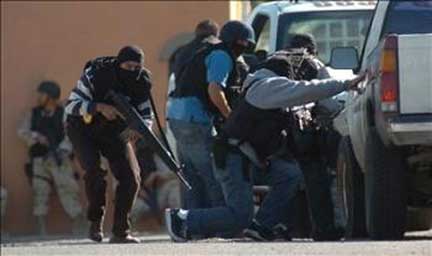 Cananea miners faced
the full force of militarized state and federal police armed for war.
(Photo: El
Imparcial/Hermosillo)
Cananea miners faced
the full force of militarized state and federal police armed for war.
(Photo: El
Imparcial/Hermosillo)
In December, a delegation
of the Union of Workers of the Metropolitan Autonomous University
(SITUAM)
traveled from Mexico City to show their solidarity with the Cananea
miners.
They brought with them a symbolic donation of $500 in food and an
enormous
banner announcing their “fraternal greetings” to the “worthy strike of
the
miners of Cananea.”
In a declaration
implementing a resolution of the 39th Special General Congress of the
SITUAM,
they proclaimed: “We recognize that the Cananea strike needs immediate
and
unconditional support in order to resist the attacks of the murderous
bosses of
Grupo México.” The declaration called on the organized workers
movement “to
join together to show their solidarity with this important miners
strike, as
well as the felt demand for the recovery of the bodies of the miners
who were
murdered in Pasta de Conchos last year” (Dossier Político,
19 December
2007).
Inside SITUAM, supporters
of the Proletarian Struggle Committee (CLP), linked to the Grupo
Internacionalista/Mexico, have been working since August to mobilize
the union
in support of the miners strike. At this moment, the union at the
Metropolitan
University is deciding whether to go on strike over its own contract
[SITUAM
went out on strike on the afternoon of February 1], as contracts in
various
unions in and around Mexico City are up this month. The CLP is calling
for a
joint strike by all university workers unions in the region, as well as
for a
national strike mobilization against the Calderón government.
Forge a Class-Struggle,
Revolutionary Leadership
For now, an injunction
granted by a federal court has annulled the second declaration of
“non-existence” of the Cananea strike by the federal Labor Secretariat.
But
behind this ruling stands the will to struggle of the miners, who
wouldn’t let
themselves be intimidated during five months of supposed non-existence
of their
strike. Their strike has such a forceful existence
that the owner, Grupo México, complains of losing
$3.5 million a
day due to the stopped production.
Still, there is an
indisputable fact: the Cananea miners are fighting almost entirely on
their
own. On strike together with Local 65 of the Union of Mineworkers,
Metalworkers
and Allied Trades (SNTMMSRM, by its initials in Spanish) are only Local
201 in
Sombrerete, Zacatecas, and the silver miners of Local 17 in Taxco,
Guerrero
(where the bosses have recently threatened to close the mine). On
January 15,
there was an eight-hour strike by something over 20,000 miners
protesting the
police assault in Cananea. But much more is needed in order to land a
solid
blow against the bosses and their government which are acting in tandem
against
the miners.
A big national strike of
the entire Mexican mining industry is urgently needed, extending to
steel
production and all parts of the Grupo México conglomerate,
including railroads.
At the same time, since the government/management attack on the miners
is the
lead of a general assault on the Mexican working class, both at the
legal level
(the threatened “reform” of the Federal Labor Law) and economically
(the brutal
price hikes for basic products due to the gasolinazo [the
sharp increase
in gasoline prices that went into effect January 6] and other
anti-worker
measures), a national strike against the starvation and repression
policies
of the government is needed.
Nevertheless, and despite
the attacks of the Labor Secretariat against STMMSRM chief Gómez
Urrutia, the
leadership of the corporatist labor organization has scrupulously
followed
Mexico’s corporatist labor laws. For their part, the reputedly
“independent”
unions of the National Workers Union (UNT) and Mexican Labor Front
(FSM) have
not lifted a finger to solidarize in action with the Cananea
strikers.
In 2006 as well, the UNT and FSM let the teachers, workers and Indians
of
Oaxaca go it alone for more than six months against the government of
the
murderer Ulises Ruiz Ortiz.
The “unions” of the CT,
CTM, CROC, CROM and other corporatist federations embedded in the state
apparatus acted for long decades as labor police for the state-party
regime of
the PRI-government (Institutional Revolutionary Party), in order to
head off
the formation of genuine workers unions. Today they continue their
“institutional” support for the PAN. The “independents,” on the other
hand, are
politically tied to the PRD (Party of the Democratic Revolution), a
bourgeois
populist-nationalist party. While the latter denounce “neo-liberalism,”
they
obey the rules of capitalism. And all these capitalist parties (along
with
their satellites) are co-responsible for the massacres of workers,
teachers,
peasants and students in recent years.
In Oaxaca, Atenco, Lázaro
Cárdenas and now again in Cananea, the workers have put up a
tenacious
resistance against the deadly ruling-class attack. However, it has not
gone
beyond this. They’re stuck in endless resistance when there should be a
struggle for power. For that, what’s needed is a class-struggle
leadership of
the unions that has broken all ties to the bourgeois state and parties,
and the
building of a revolutionary workers party armed with an
internationalist
program.■
See
also: New
York Picket Protests Repression Against Mexican Miners (11
January 2008)
Mexican
Miners Strike for Safety (15
December 2007)
Cananea: A Century of Internationalist
Class Struggle (December 2008)
To contact the Internationalist Group and the League for the Fourth International, send e-mail to: internationalistgroup@msn.com